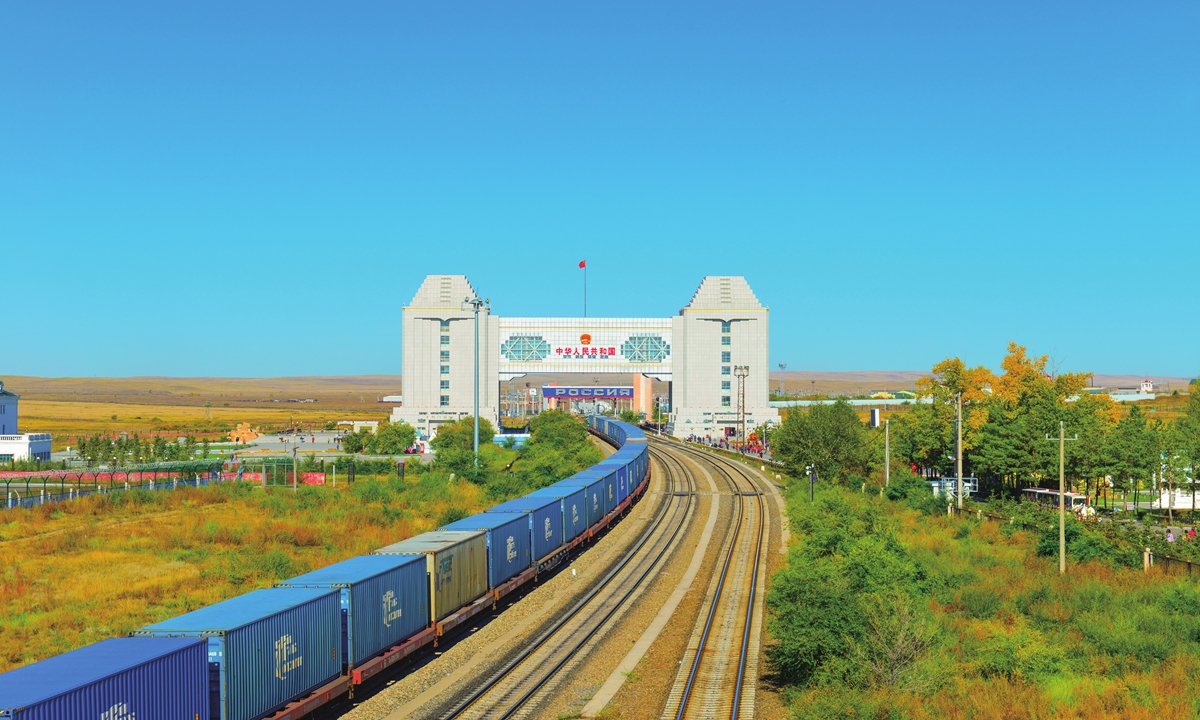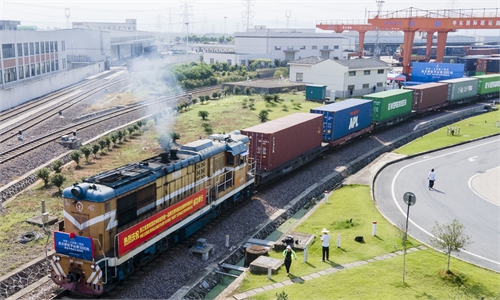China-Europe freight train a pillar in global trade
Six years of resilient growth set a good example for cross-continental transportation under a shared future

A train pulls out from Manzhouli customs. Photo: Courtesy of Han Zongjiang
Editor's Note:
In 2013, Chinese President Xi Jinping put forward the "Belt and Road Initiative" (BRI), aiming at building a new platform for international cooperation and creating new momentum for shared development. Since then, the BRI has opened a path for high-quality development and common prosperity for countries along the route, becoming a real global platform serving over half of the world's population.
While developing rapidly over the years, China has also made great contribution to the world connectivity under the initiative, helping to build a mega global transportation network covering sea, rail and road channels and integrating a number of countries into the global supply chain.
The Global Times is publishing a series of stories, helping the world understand how the initiative facilitates connectivity and foster growth. One of the typical examples includes the opening of China-Europe freight train. The sixth anniversary of the opening of the train falls on June 20, and the Global Times conducted interviews with several train operators, traders and customs officials, who shared how they witnessed the development of freight transportation under BRI and its increasingly important and indispensable role for global economy.
This is the first in a series about a monumental decade for the BRI.
When Bao was designated by the government of Yiwu, East China's Zhejiang Province, to deliver the first shipment of goods via the cross- border freight train to Madrid in 2014, he was deeply worried as a trader since hardly anyone would believe that a freight train with a mileage of up to 13,000 kilometers across the Eurasian continent could work.
Now, the train dispatched from Yiwu to major cities in Europe has become the pillar in cross-border transportation, with the numbers of trains dispatched last year reaching 1,277, and is expected to reach up to 1,600 this year, a historic high, compared with just one train in 2014.
While the launch periods of the trains were different from place to place, the official naming of the China-Europe freight train as a national brand was made by China Railway in June 2016, which was also the most fruitful year for China-Europe freight trains. From that year on, its role as a China-EU trade messenger was preliminarily established.
It was also in 2016 when the average numbers of trains dispatched from Yiwu to Europe was upped to two trains per week instead of one train per month, while the category and value of cargo delivered via the trains was diversified, industry insiders said.
From 2016 to 2021, the annual number of China-Europe freight trains increased from 1,702 to 15,183, with an average annual growth rate of 55 percent.
Moreover, the types of cargo delivered via the trains expanded from mobile phones to more than 50,000 kinds of goods including vehicles and bulk commodities like grain and wood, mostly value-added goods.
In the face of the severe impact of the pandemic, the China-Europe freight train has bucked the trend and kept growing, with 78 operating lines reaching 180 cities in 23 European countries.
Quantity and quality combined
Speaking on the occasion of the sixth anniversary of the official naming of China-Europe freight train, Bao was excited about how the train service has changed his trading business.
The advantages of the freight train center on its high efficiency and reliability as the global logistic hurdles intensify amid port congestion in the US and Europe.
While there has been congestion abroad, taking over a month by sea from China to Germany only takes 18 days or less by train in recent years, Bao said, which is also a progress from 21 days in 2014.
"Previously, the volume of sea transportation accounted for 70 percent of our entire transportation volume, whereas now more than 70 percent of transported goods from our trading business go through China-Europe freight trains," Bao said.
In addition to shipments, the biggest changes are in the segmentation of clients and value of goods.
At the beginning, they were all small business owners, and the goods sent were mainly less value-added daily commodities. But now, the goods delivered via the train are mainly automobiles and electronic devices while clients have upgraded from small business owners to global trading giants, according to Bao.
The changes that trains have brought to international trade are visible across the country.
Ma Yanyan, a customs broker in Ulanqab, North China's Inner Mongolia Autonomous Region, who joined in the China-Europe freight train business in 2018, told the Global Times on Monday that she helped around 100 trains in Ulanqab each year for going through the customs clearance process.
"During 2018-2020, the number of trains dispatched annually witnessed a 20 percent growth year-on-year, and the freight train was a stable channel for China to export various goods amid dynamic global environment," said Ma.
Ma's company operates clearance service for freight trains dispatched from Ulanqab to European countries via the Erenhot land port. She noted that China-Europe freight train was barely affected by Russia-Ukraine conflict.
At Manzhouli railway port, the largest of its kind in China, and the major conjunction of the China-Europe freight train, in North China's Inner Mongolia Autonomous Region, the train service has seen a significant upgrade, under the hard work of local customs.
To further facilitate the efficiency of port clearance while doing a good job for epidemic control, Manzhouli customs have adopted various measures including 24-hour work shifts and intelligent contactless inspection methods such as cobalt-60 scanned images, an advanced imaging technology, to improve the efficiency of inspection work, Manzhouli customs told the Global Times.
Local customs is also in close coordination with other customs along the route to ensure the smoothness of the supply chain.
Good trend ahead
Since the cross-border train was launched at Manzhouli port in 2013, 15,200 trains have been dispatched from the city so far, according to the customs, and the figure is still rising year-on-year.
As the trade demand continues to grow, Manzhouli is set to build a China-Europe freight train hub site or assembly center, while the port customs is to carry out cargo grouping business and mixed transportation of domestic and foreign goods in further releasing China-Europe freight train transportation capacity, the Global Times learned.
Ma predicted that the operation of China-Europe freight train in the rest of 2022 will benefit from the good relationship between China and Russia.
"Customs in different ports also granted supportive policies to freight trains such as special office hours during holiday and weekends, which simplifies the export procedures," said Ma.
Driven by the trend of more goods delivered faster, the annual transportation value of the China-Europe freight train has increased from $8 billion to $74.9 billion from 2016 to 2021, an increase of nine times, and its proportion in the total trade volume between China and Europe has increased from 1.5 to 8 percent.
Despite high shipping prices, slot shortage, epidemic prevention and control, and Russia-Ukraine conflicts, the China-Europe freight train continues to operate largely unaffected, and has played an irreplaceable role for China-European trade throughout the period, Tommy Tan, president of Shanghai EPU Supply Chain Management, an agent of China-EU freight trains, told the Global Times.
"Non-contact cargo track change, 24-hour high-speed operation, reasonable and stable cost, have all become irreplaceable advantages of cargo trains compared with that of sea and air transportation," Tan said.

